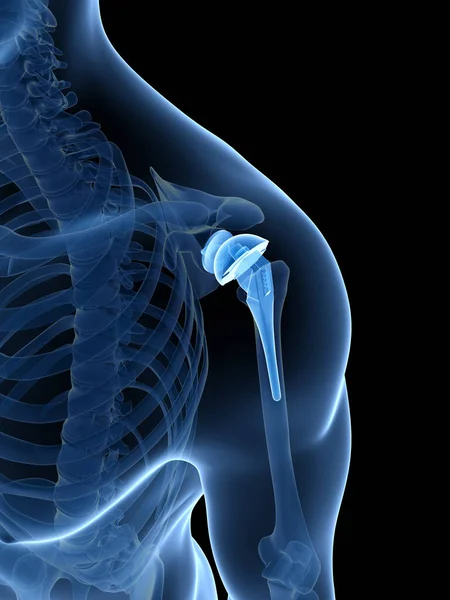A major dysfunction in the shoulder joint often leads to a shoulder replacement surgery. Joint dysfunction may be caused by a degenerative disease, like arthritis, or may be due to an accident or injury. There are also congenital defects that can eventually require shoulder replacement surgery to restore function to the joint. No matter the cause of shoulder joint dysfunction, replacement surgery entails the removal of part of or all of the joint, and replacement of those parts with synthetic joint components that are intended to restore normal operations in the joint.
Permanent Restrictions After Shoulder Replacement
A shoulder replacement surgery (also known as a total shoulder arthroplasty) is a procedure in which damaged portions of a person’s shoulder joint are replaced with artificial implants in order to restore mobility, range of rotation, and decrease pain. Shoulder replacements usually have a high success rate in terms of their ability to manage and treat the severe stiffness and pain patients previously experienced—likely as a result of severe arthritis.
success rate in terms of their ability to manage and treat the severe stiffness and pain patients previously experienced—likely as a result of severe arthritis.
The full recovery from a shoulder replacement typically ranges from four to six months. That being said, some people’s recoveries can be longer and sometimes shoulder replacement surgery can leave patients facing lifelong restrictions. The specifics of permanent restrictions after shoulder replacement surgery are dependent on the type of shoulder replacement procedure performed. Typically, during the recovery period from shoulder replacement surgery, people are not allowed to lift anything over approximately 25 pounds, drive before approximately 12 weeks, rely on their shoulders for too many things, reach out too far with their recovering shoulder, or support themselves with their recovering shoulder. However, it is critically important to note that these restrictions after shoulder replacement surgery are dependent on the individual patient and their doctor’s instructions. Patients should undoubtedly adhere to their doctor's plan of care and recovery timeline for them.
Finally, it is typically found to be the case that permanent restrictions after shoulder replacement surgery can be avoided if the patient adheres to and carefully follows their physical therapy routines and schedules as well as those of other recovery treatments.
Reverse Shoulder Replacement Surgery
Reverse shoulder replacement surgery is another type of shoulder replacement surgery during which the damaged portions of the bone are removed and replaced with portions (“implants”) composed of plastic and metal. The shoulder is a ball-and-socket joint. And damage to this joint—brought about by arthritis and other inflammatory disorders, and injuries—can result in a shoulder replacement becoming necessary in order to provide you with full range of motion and rotation as well as a reduction in the amount of pain you are currently experiencing.
Reverse shoulder replacement surgery is typically performed on people who have suffered rotator cuff injuries that have left the shoulder severely damaged. The procedure for a reverse shoulder replacement surgery is a little different than the other two types of shoulder replacement surgeries. This is because a reverse shoulder replacement surgery involves replacing both the ball and socket of the shoulder joint with implants that are reversed. In other words, the installation of the implants during a reverse shoulder replacement surgery results in the socket of the shoulder joint being attached to the upper arm bone and the ball component of the shoulder joint being attached to the shoulder blade.
Applying for SSD with a Shoulder Replacement
If you’ve undergone shoulder replacement surgery and remain severely limited following the procedure, you may need to file for Social Security Disability (SSD) benefits.
The Social Security Administration (SSA) uses the “Major Dysfunction of a Joint” section (1.02), listed in the Blue Book under Musculoskeletal conditions (1.00) to evaluate disability claims based on shoulder replacement surgery and shoulder joint dysfunction.
You’ll need to include extensive medical records and other documentation in your SSD application. Records should include:
- Statements from your physician(s) indicating the limitations imposed by your condition
- Notes from physical examinations showing limited range of motion in the shoulder joint
- Imaging results showing any organic defects in the shoulder joint and surrounding tissues
- Evidence that your condition has lasted, or is expected to last, 12 months of more
Shoulder Replacement and Medical Vocational Allowance
 Most applications for SSD benefits based on a shoulder replacement don’t qualify for benefits under the major dysfunction of a joint listing in the Blue Book. If this is true in your claim, you may still be found eligible for SSD benefits, if you meet the requirements for a “Medical Vocational Allowance (MVA)."
Most applications for SSD benefits based on a shoulder replacement don’t qualify for benefits under the major dysfunction of a joint listing in the Blue Book. If this is true in your claim, you may still be found eligible for SSD benefits, if you meet the requirements for a “Medical Vocational Allowance (MVA)."
A medical vocational allowance requires the SSA to review your medical records and you work history and qualifications to determine if your condition is severe enough to prevent you from finding and maintaining gainful employment. In order to establish your disability, your application for SSD and your supporting documentation must show you’re unable to perform other common job duties, like:
- reaching and bending
- lifting and carrying
- typing, writing or operating equipment,
- sitting or standing in one location for any length of time without shifting your weight or changing position
Medical Records to Prove Shoulder Replacement
 In addition to the documentation previously stated, your application for SSD benefits should include:
In addition to the documentation previously stated, your application for SSD benefits should include:
- all your medical records
- diagnostic evaluations and related notes
- tests performed and the results from those exams
- medications and other treatments or therapies you’ve tried
- detailed statements from your treating physician(s)
To qualify for SSD benefits, you’ll need to prove you’re unable to work in your previous field of employment. You must also show your shoulder replacement imposes such severe limitations that you can’t maintain gainful employment in any other field either. In other words, your condition must be proven to prevent you from working in any job for which you might otherwise be qualified.
Getting Help with Your Shoulder Replacement SSD Application
Proving a disability claim for a shoulder replacement can be difficult, especially as the majority of joint replacement surgeries go well, restoring joint function and range of motion for most patients. Extensive documentation of your medical condition and the limitations it imposes will be necessary for proving your disability. Working closely with your medical doctor is critical in your SSD application. Getting help from a Social Security advocate or attorney can also be very beneficial – helping you construct a thorough application and case file, thereby increasing the chances you’ll be approved for SSD benefits.